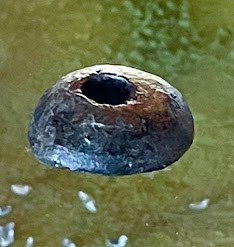A Whale of a Time, Bergs Not So Much with a Side of Norse
St. Anthony's is known as the centre for Vikings, bergs and whales so we booked a boat tour that promised us both icebergs and whales. We woke happy to see clear skies. It was a little breezy but in the protection of the harbour it did not seem like it was going to be a problem.
Wrong! As we exited the harbour the wind hit with such a force that had the boat rocking front to back and side to side all at once. My kinetosis was going to be tested.
As we headed out the captain informed us that the iceberg he had visited just off shore yesterday was now 3 kilometres off shore due to the high winds. Oh, oh!
Photo: Was taken by one of our fellow passengers with a super telephoto lens
Saved by a whale. Within a few minutes of leaving the harbour, we spotted two vapour spouts, sure signs of whales. The berg was quickly forgotten to follow the whales. Very likely the ones we had seen on our hike along the Lamage Point Trail.
I had purchased a new camera for the trip with an impressive zoom lens specifically for berg, moose and whale sightings. The auto focus works well if you are standing still but not so much when you are trying to aim the camera in a bucking boat feeling like you want to throw up.
Thanks to the marvel of digital cameras I took over 90 shots but the boat was moving so much that I was never able to capture the whale breaching in a tight frame. My first 70 shots were of empty ocean. I opened the frame wider for the last 20 and managed to catch a bit of whale in some of them, most often on the edge of the shot. Thanks to Photoshop and their cropping tool I can prove we saw some humpback whales.
I eventually gave up and just enjoyed the sightings storing them in my cranial memory bank. Well, at least till Alzheimer's set in.
The whales allowed us to visit with them for over an hour but no acrobatics today, they were busy feeding.
This left us without enough time to run out to the iceberg. But they did have a fall back berg. The same one we had seen on or first day arriving into St. Anthony. It had become trapped in the bay and would likely end its day melting away there. Once we entered the bay, protected from the wind my puke meter went down a couple of notches.
We were lucky to see a small iceberg roll over on our trip up Tracy Arm near Juneau Alaska. The colour of the newly exposed ice was a stunning glistening blue like that of an expensive diamond.
Photo: Tracy Arm Alaska 1998
I spent the rest of the day with some vertigo and queasiness. Tomorrow we head to L'Anse aux Meadows and the wind is forecast to be the highest we have seen yet. It will be our last day before we start our journey home and I think the Rock wants to give us good send off.
L'Anse aux Meadows- Parks Canada
At the tip of Newfoundland’s Great Northern Peninsula lies the first known evidence of European presence in the Americas. Here Norse expeditions sailed from Greenland, building a small encampment of timber-and-sod buildings over 1000 years ago
Photo: Getty Images
Against a stunning backdrop of rugged cliffs, bog, and coastline, discover the fascinating archaeological remains of the Viking encampment, declared a UNESCO World Heritage Site in 1978.
Growing up in the 50's I was taught that “in 1492 Columbus sailed the ocean blue” and discovered America. We now know the Vikings were the first Europeans to visit America by 500 years thanks to the discoveries made at L'Anse aux Meadows. Based on carbon dating it is estimated that the Vikings occupied the site between 990 and 1050 C. According to Wikipedia it is the only undisputed site of pre-Columbian trans-oceanic contact of Europeans with the Americas.When the site was first discovered it was thought to be an indigenous site. Evidence that at least 5 different indigenous groups occupied site with the oldest dating back 6,000 years. None of which were contemporaneous with the Norse occupation. Exploration starting in 1960 and over the next 7 years uncovered the remains of 8 structures that compared to similar sites in Greenland and Iceland circa 1000 BC.
Artifacts recovered from the excavations included iron nails, tools and other sundry Norse-style items. The artifact that sealed the confirmation that it was a Viking settlement was a small object called a wood spindle and similar to ones found on Greenland and Iceland.
Photo:themaritimeexplorer.ca
The site is on a wind swept point. Today the wind speeds had gusts of 70 kph. Made me wonder why the Vikings would pick such a miserable place? But 1200 years ago the site was a different place with stands of balsam, larch and birch trees growing around it.
Books written around 1200 C (The Saga of Erik the Red, The Saga of Greenlanders) gave accounts of Norse voyages to Vinland, thought to be the coasts of North America. A statue of Viking explorer Leif Erikson has been erected in the small town of L'Anse aux Meadows as an attraction to a well known restaurant, Leif Erikson's saga was that he had been blown off course by a powerful storm while returning from Norway to Greenland and ended up on the Rock.
Our trip is almost over and the Rock did not disappoint. It blew us away with its scenery, the friendliness of the people and its gale force winds. Will we be back? We would if we could but we are running out of time and we still have so much to see and do.

















No comments:
Post a Comment